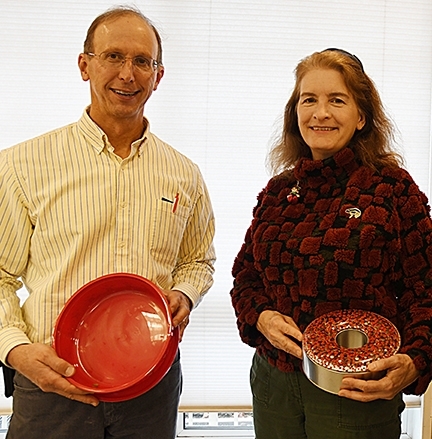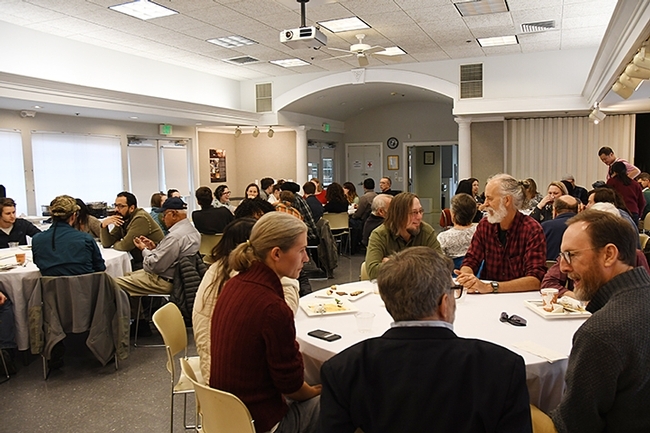
Sounds like a great story, right?
Make that great cookies.
They weren't there to present their research on nematodes, aquatic insects or pollinators. They were there to enjoy some camaraderie at the UC Davis Department of Entomology and Nematology's holiday party, and...drum roll...they won the top prizes in the cookie contest.
- Best chocolate cookie: Aquatic entomologist Sharon Lawler, professor, UC Davis Department of Entomology and Nematology, for her recipe, "Dirty Drunk Snowballs"
- Best non-chocolate cookie: Nematologist Steve Nadler, professor and chair, UC Davis Department of Entomology and Nematology, for his Internet-modified recipe, "Cranberry Orange Cookies"
- Best decorated cookie: Community ecologist Rachel Vannette, assistant professor, UC Davis Department of Entomology and Nematology, for her "Stamped Citrus Shortbread" recipe from the New York Times
William Tuck, academic personnel specialist in the Phoenix Cluster, which serves the Department of Entomology and Nematology and the Department of Plant Pathology, coordinated the event and awarded $25 Amazon gift cards to the winners.
The proof of the pudding? Empty containers.
Want to make the recipes? They shared!
Dirty Drunk Snowballs
By Sharon Lawler
Ingredients:
1 box Trader Joe's Mini Dark Chocolate Mint Stars
1/4 cup dark rum (white rum or bourbon will also work)
1/4 cup confectioner's sugar
Method:
Grind up the cookies in a food processor or blender until pretty fine but with some texture left. Stir enough dark rum so that the crumbs hold together well, but stop before it gets soggy. Let the mix sit for 15 minutes or so. Sift the confectioner's sugar into a bowl. Roll the mix into small balls, and then roll them in the confectioner's sugar.
Cranberry Orange Cookies
By Steve Nadler
Internet-modified recipe
Ingredients:
1 cup unsalted butter, softened
1 cup granular white sugar
1/2 cup brown sugar (packed)
1 egg
1-1/2 teaspoons grated orange zest
5 tablespoons orange juice
2-1/2 cups all-purpose flour
1/2 teaspoon baking soda
1/2 teaspoon salt
2 cups orange-flavored dried cranberries (Trader Joe's)
1-1/2 cups confectioner's sugar
Method:
- Use a food processor to chop the dried cranberries
- Preheat oven to 375 degrees F.
- In a large bowl, blend together the butter, white granular sugar, and brown sugar until smooth.
- Whisk the egg in a small bowl, then mix into the large bowl.
- Add 1 teaspoon of orange zest and 2 tablespoons of orange juice into the large bowl and mix.
- In a separate bowl, mix together the flour, baking soda, and salt.
- Stir the flour mixture from step 6 into the large bowl.
- Mix in the chopped cranberries, working to distribute them evenly.
- Drop cookie dough mixture (rounded tablespoon) on ungreased cookie sheets. Space them 2 inches apart.
- Bake for about 12 minutes in the preheated oven (375 F). The edges will begin to turn golden brown when ready.
- Remove cookies from sheets and cool on wire racks.
- In bowl, mix 1/2 teaspoon orange zest, 3 tablespoons of orange juice, and the confectioner's sugar until smooth. Brush on the tops of the cooled cookies. Let dry.

By Rachel Vannette
Recipe from New York Times
For the Cookies
- 2 cups/255 grams all-purpose flour, plus more as needed
- ? cup/45 grams cornstarch
- ½ teaspoon kosher salt
- 1 cup/225 grams unsalted butter (2 sticks), softened
- ½ cup/100 grams granulated sugar
- 1 orange (preferably tangelo)
- 1 lemon
- ½ teaspoon vanilla extract
- ½ teaspoon lemon extract
- ¾ cup/75 grams sifted confectioners' sugar
- 1 tablespoon melted butter
- 1 tablespoon fresh orange juice, plus more as needed
For the Glaze:
- 3/4 cup/75 grams sifted confectioners' sugar
- 1 tablespoon melted butter
- 1 tablespoon fresh orange juice, plus more as needed
Preparation
- Prepare the cookies: Add flour, cornstarch and salt to a medium bowl, and whisk to combine. Set aside.
- Combine butter and granulated sugar in the bowl of a stand mixer fitted with the paddle attachment. Zest half the orange and half the lemon directly into the bowl. Reserve the lemon and orange for the glaze. Cream the butter mixture on medium-high speed until light and fluffy, 2 to 3 minutes. Add vanilla and lemon extracts and beat on medium speed until well combined, scraping the bowl a few times as needed.
- Add the flour mixture to the butter mixture and beat on low speed just until combined. Scrape the bowl and fold a few times to make sure everything is well combined. Wrap dough in plastic wrap, flatten into a disk, and chill until firm, at least 1 hour, and up to 3 days.
- Heat oven to 350 degrees. Cut dough in half and let one piece warm up for 30 minutes if it has chilled longer than an hour. Return the other half to the refrigerator. Portion the dough into pieces roughly the size of walnuts (a scant 2 tablespoons/about 35 grams), then roll each piece into a ball between your hands. One at a time, dip a ball of dough into flour and set on work surface. If dough balls soften too much, return them to the refrigerator to firm up for a few minutes. You want it cool, but malleable. Dip cookie stamp in flour, and press down on the ball of dough until it is about 1/4-inch thick. Remove stamp. (If dough sticks to stamp, carefully peel it off. Don't worry about excess flour as you will brush it off after chilling.) Trim the edges using a 2-inch cookie cutter, and transfer dough rounds to 2 parchment- or silicone mat-lined baking sheets, arranging them about 1 1/2 inches apart. Repeat with remaining dough.
- Once you have stamped out all the cookies, knead together the scraps to make a few more. Chill in the freezer until very firm, about 10 minutes. When cold, brush off any excess flour with a dry pastry brush.
- Bake until cookies just start to turn golden underneath, 12 to 14 minutes, switching the baking sheets from front to back and top to bottom halfway through baking time.
- Make the glaze while the cookies bake: Zest the remaining skin from the reserved lemon and orange into a small bowl. Add the confectioners' sugar, butter and orange juice and whisk until smooth. If glaze is too thick, add more orange juice. If it is too thin, add more confectioners' sugar. It should be the consistency of thin custard.
- Let the cookies cool for a few minutes on the baking sheets, and transfer to a wire rack set over a parchment- or wax paper-lined baking sheet. Pick up a cookie, and using the back of a small spoon, spread a generous teaspoon of glaze on a cookie, letting any excess drip onto the next cookie. Repeat until all the cookies are glazed. Cool completely. Cookies will keep in an airtight container at room temperature for up to 1 week.
Attached Images:
